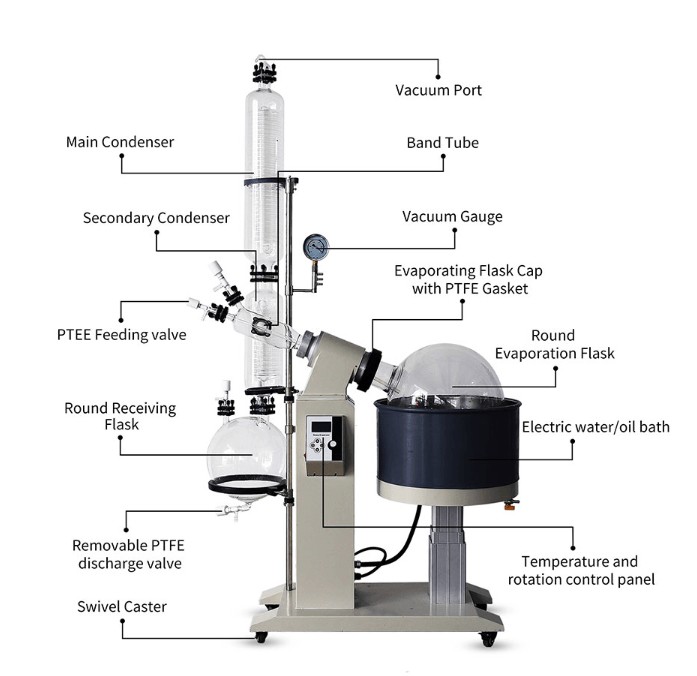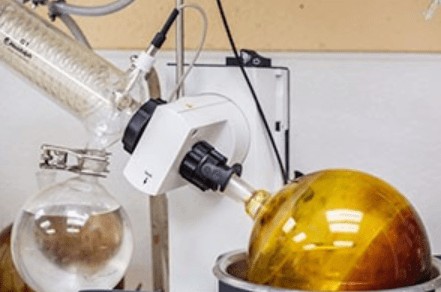A rotary evaporator is an expensive laboratory apparatus that is used for gentle and efficient removal of solvents from various samples by means of evaporation. This process necessitates the removal of extra solvents from less volatile samples.
Rotary evaporators are very important and are found in every organic laboratory because of their efficiency in performing this task. A rotary evaporator has a water bath that you can efficiently heat on a crystallization dish or a metal container; this is important ait keeps your solvent from freezing.
How Does A Rotary Evaporator Work?
A rotary evaporator works by the general assumption that at each given time, the boiling point of the solvent in question is much lower than the boiling point of the liquid surrounding it. As the boiling point of liquids slowly reduces when you decrease their pressure, it allows the solvent to be vaporized at lower temperatures than their standard boiling point at normal pressure. The other assumption is that the components in the liquid are usually thermally sensitive.

The working principle of a rotary evaporator is not a complicated one; it works by first creating a vacuum space in the rotary glass flask. The vacuum system is essential in the whole process of evaporation as it accomplishes the entire process that is why it is highly recommended to use a highly improved vacuum pump if you want to enhance evaporation efficiency. The work of the condenser at the other end is to aid in converting the gas back to a liquid form that needs lower temperatures.
So as to achieve an efficient cooling effect, there’s a need to use dry ice, liquid, or water nitrogen. The evaporation vessel is set to evaporate so that to increase the surface area, the boiling liquids continuously. The centrifugal force that is created keeps the liquid in the evaporator to stick in the walls of the vessel; this exposes a larger surface area for Carter evaporation.
Temperature and pressure are linearly related to each other, so when that temperature is doubled on a Kelvin or absolute zero scales, it will force the temperature to double so long as the volume area is kept constant. Also when the presided is reduced when you turn on the vacuum, it lowers the boiling point in the process to allow the volatile solvent to evaporate. And the evaporated solvent is, in turn, captured on a cooled surface where the gas molecules condense upon.

The most common way to create a condensation area is to mix dry ice and isopropyl alcohol. You can add dry ice continuously, but it should not be cold enough to freeze the alcohol content. Along with this process, a flask is placed in a heated bath that is kept in rotation. This is aimed at creating a thin film in the flask that increases the surface area for gas molecules to evaporate. It also helps to conduct heat directly into the system to keep the temperatures constant as the molecules evaporate off.
When the vacuum is created, the gas molecules will begin to condense on the cold surface. The required conditions are such that evaporations continue simultaneously from the whole surface, including from inside the liquid. The result is bubbling, which is another reason why a rotary motor is used in evaporation.
The uses of a rotary evaporator are very efficient and simple, and it is a tool that is widely used in cannabis extraction or chemical labs.
The Procedure of Using A Rotary Evaporator
Using a rotary evaporator is not complicated of a process, it follows the following procedure:
1. The setup of a rotary evaporator
- The first step is to pour the solvent mixture and the compound you want to work on in a round bottom flask. It is advisable to fill the flask less than a half if you want to get the desired results.
- The second step is to fill the rotary evaporator cold traps using dry ice
- After filling the cold traps, you then have to attach a glass bump trap to prevent the solution from entering into the main part of the rotary evaporator. This is made firm by securing it with a Keck clip.
- After attaching a Keck clip, attach the pump trap and the flask to the adaptor of your rotary evaporator.
- The fifth step is to lower your flask into a water bath. This aims at preventing your flask from disconnecting.
2. The operation of a rotary evaporator
- The first step is to start that rotation, check on the correct speed for your volume as different volumes require different speeds.
- Start increasing the vacuum owly by slowly. A vacuum is at a proper strength when it is possible to see the condensation of the solvent in the receiving flask or when the solvent starts to bubble.
- The next step on the operation of a rotary evaporator is to turn on the heat for your water bath. As we all know, vacuum reduces that boiling point, so this will significantly the temperature needed to evaporate your solvent.
- Make the adjustment needed for that vacuum.
- After the whole solvent has been removed, the next thing is to turn your vacuum off and return the flask to the normal pressure, atmospheric pressure and immediately stop the rotation.
- Remove the flask from the water bath and the flask from the adaptor.
3. Something you need to pay attention when using a rotary evaporator
When using a rotary evaporator, you need to pay attention to the rotation rate, make sure you rotate the flask moderately, preferably one- third of the maximum allowable value.
A rotary evaporator is a very important apparatus that is used to carry our important tests and extraction of a substance from a solution. It is important always to remember to remove the algae gunk from the coiled water condenser so increase its life span.
More WKIE LAB Rotary Evaporators for Different Usages:
- Educational Rotary Evaporator
- Rotary Film Evaporator
- Industrial Rotary Evaporator
- Laboratory Rotary Evaporator
Conclusion
After reading this post, you may realize how does a rotary evaporator work. That is a very crucial step before you using a rotovap.

